The preliminary results of the Annual Labor and Employment Estimates for 2018 based on the average of the four Labor Force Survey rounds (January, April, July and October) reported an annual labor force participation of 61.7 percent out of 3.5 million population 15 years old and over in Ilocos Region. This is equivalent to about 2.2 million economically active population comprising of either employed or unemployed persons.
The annual employment rate in 2018 of Ilocos Region is 93.2 percent. This was 2.1 percentage points higher than the employment rate recorded in 2017 at 91.1 percent. Compared with the 94.7 percent national figure, Ilocos Region’s employment rate was lower by 1.5 percentage points. Meanwhile, the employment rate of the country in 2018 was slightly higher by 0.4 percentage point than the employment rate recorded in 2017 at 94.3 percent.


Among the 17 regions in the country, Cagayan Valley posted the highest employment rate at 97.0 percent in 2018. On the contrary, Ilocos Region recorded the lowest employment rate at 93.2 percent.
Ilocos Region posted the highest increase in employment rate of 2.1 percentage points from 91.1 percent in 2017 to 93.2 percent in 2018. On the other hand, Central Visayas recorded the biggest decrease of 0.8 percentage point from 95.5 percent in 2017 to 94.7 percent in 2018.

Males (62.1%) dominated females (37.9%) in terms of employment in 2018. Similarly, employed males (64.6%) outnumbered employed females (35.4%) in 2017.

It is manifested in Figure 3 that nearly half (49.3%) of the employed persons in Ilocos Region in 2018 were either in Junior High School level or graduated from Junior High School. Those who attained college level and elementary level followed accounting for 26.1 percent and 18.4 percent respectively of the total employed persons in the region in 2018. On the other end, those with no grade completed (0.5%) comprised the smallest proportion of the total employed persons in the region.
Similarly, employed persons who attained Junior High School Level also had the biggest share in 2017, with 48.5 percent. It was followed by employed persons who reached college level and elementary level with 26.0 percent share and 20.4 percent share respectively. Employed persons who reached senior high school level recorded the least percent share with less than 0.1 percent of the total employed persons in the region.
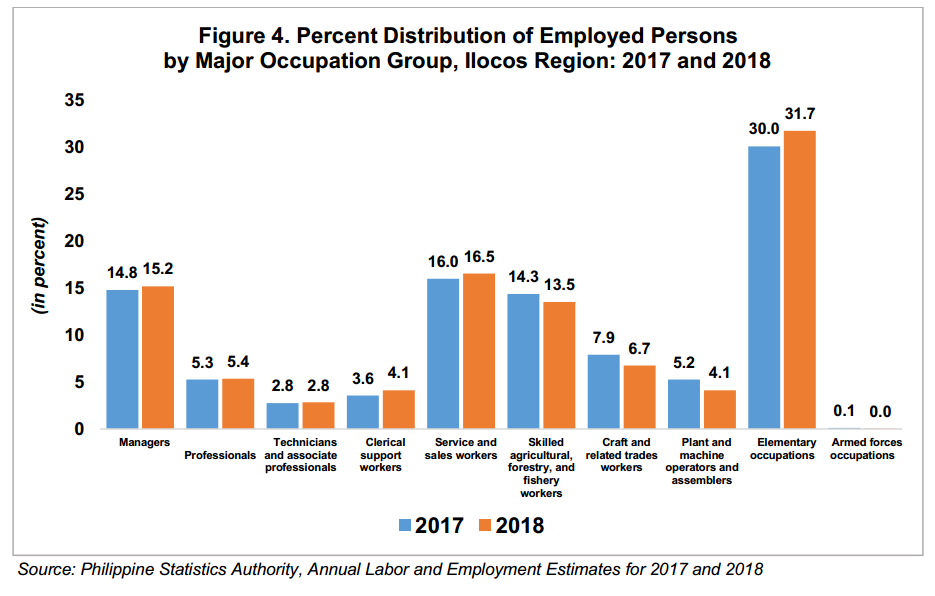
Among the various occupation groups, workers under elementary occupations comprised the biggest group making up 31.7 percent of the total employed persons in Ilocos Region in 2018. This was followed by service and sales workers with 16.5 percent share and managers with 15.2 percent share.
Similarly, in 2017, the top three occupation groups among employed persons in the region were elementary occupations, service and sales workers, and managers with 30.0 percent share, 16.0 percent share, and 14.8 percent share respectively.
On the other hand, the smallest occupation group was recorded by the armed forces and special occupations with less than one percent both in 2017 and 2018.
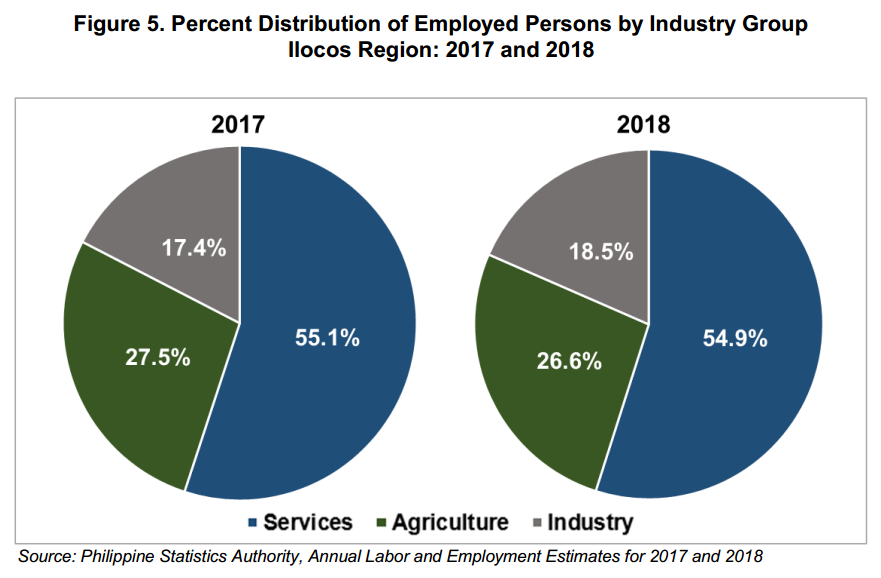
In terms of percent distribution of employed persons by major industry as shown in Figure 5, workers in the services sector comprised the largest group, making up 55.1 percent and 54.9 percent of the total employed persons in Ilocos Region in 2017 and 2018 respectively.
This was followed by workers in the agriculture sector with 27.5 percent share and 26.6 percent share in 2017 and 2018 respectively.
Meanwhile, workers in the industry sector comprised the smallest proportion of employed persons in the region with 17.4 percent share and 18.5 percent share in 2017 and 2018 respectively.
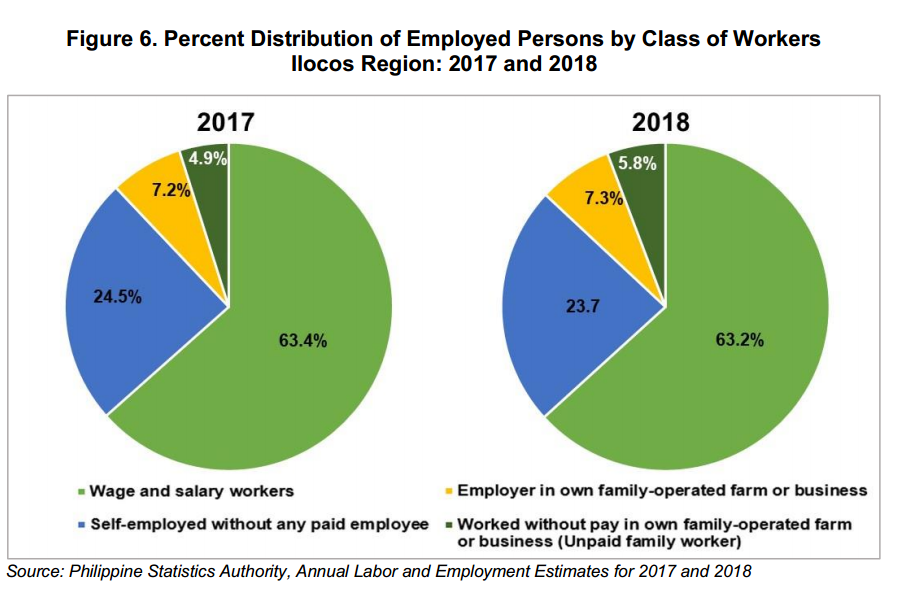
Figure 6 shows that the biggest proportion of employed persons in Ilocos Region in 2018 was recorded by wage and salary workers with 63.2 percent of the total employed persons. Self-employed without any paid employee ranked second with 23.7 percent share followed by employer in own family-operated farm or business with 7.3 percent share.
Likewise, wage and salary workers also posted the largest share in 2017 with 63.4 percent of the total employed persons in the region. It was also followed by self-employed without any paid employee and employer in own family-operated farm or business with 24.5 percent share and 7.2 percent share respectively.
On the contrary, workers without pay in own family-operated farm or business (unpaid family worker) accounted for the smallest proportion of the total employed persons in Ilocos Region in 2017 and 2018 with 4.9 percent share and 5.8 percent share respectively.
For wage and salary workers group, those who worked in private establishments comprised the biggest group with 48.0 percent share in 2018. Employed persons in government and government-controlled corporations distantly followed with 10.0 percent share while workers for private households had 5.0 percent share.
In 2017, employed persons who worked for private establishments also had the biggest proportion under the wage and salary workers group in the region with 48.7 percent share. Likewise, employed persons who worked for government or government corporations and those who worked for private households followed with 9.6 percent share and 5.0 percent share respectively.
On the other end, the smallest group was posted by employed persons who worked with pay in own family-operated farm or business with negligible share of 0.2 percent and 0.3 percent in 2017 and 2018, respectively.
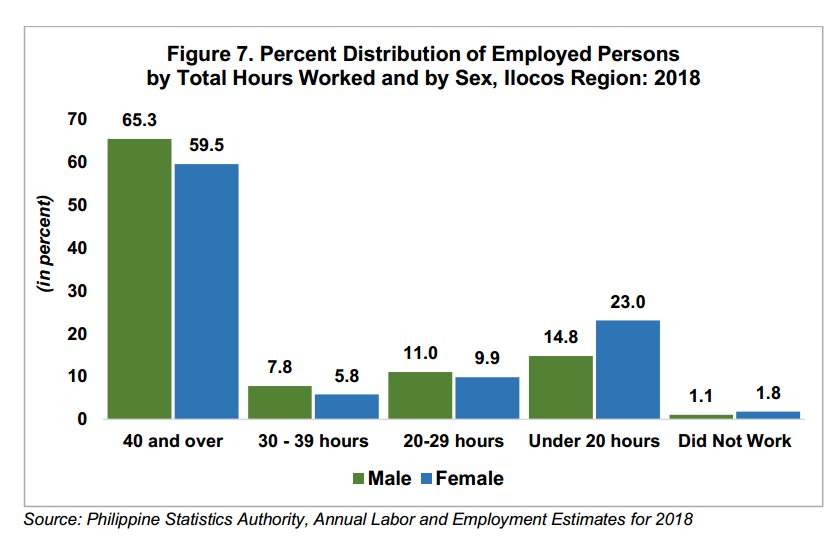
It can be gleaned in Figure 7 that most of the employed persons in Ilocos Region in 2018 for both sexes worked at least 40 hours a week with 65.3 percent of employed males and 59.5 percent of employed females. This was followed by those who worked under 20 hours a week for both sexes with 14.8 percent for males and 23.0 percent for females and those who worked 20 to 29 hours a week with 11.0 percent males and 9.9 percent females. The smallest proportion of employed persons in the region were not engaged in any work during the reference period comprised of 1.1 percent males and 1.8 percent females.
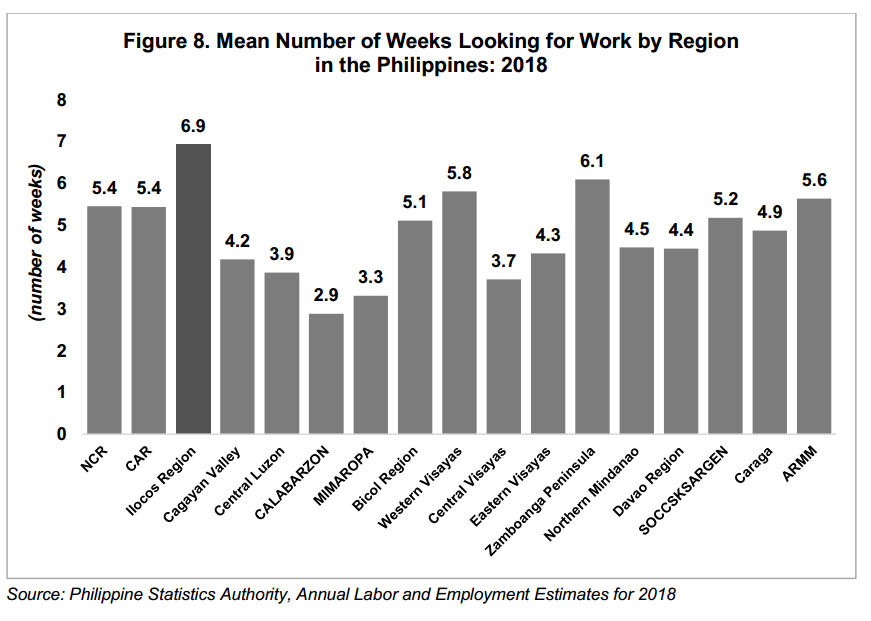
In terms of job hunting, Ilocos Region recorded the highest duration of unemployed persons looking for work with an average of 6.9 weeks as shown in Figure 8. Zamboanga Peninsula followed with an average of 6.1 weeks for unemployed persons looking for work.
On the other hand, the shortest duration of unemployed persons looking for work was posted by CALABARZON with an average of 2.9 weeks.
TECHNICAL NOTES
- The annual labor and employment statistics presented in this release for 2018 used the average estimates of labor and employment indicators from the four Labor Force Survey (LFS) rounds conducted by the Philippine Statistics Authority (PSA) on a quarterly basis. The use of the average estimates of the four-quarter rounds of the LFS data was based on PSA Board Resolution No. 01, Series of 2017-151: “Approving and Adopting the Official Methodology for Generating Annual Labor and Employment Estimates, approved on the 14th day of February 2017.”
- For 2018, the methodology for annual labor and employment estimates uses the following formula to estimate employment, unemployment, underemployment and labor force participation rates: Zi= ( ∑j Xij / ∑j Ykj ) x 100
where:
Zi = annual estimate for the rate of i where i refers to employment, unemployment, underemployment and labor force participation
Xij = estimate for the population of i for the jth round of LFS where
i refers to employed, unemployed, underemployed and labor force, and
j refers to the four rounds of LFS: January, April, July and October
Ykj = estimate for the population of k for the jth round of LFS where
k refers to labor force, employed persons and persons 15 years old and over, and
j refers to the four rounds of LFS: January, April, July and October
- The official methodology was deemed the most appropriate among methodologies reviewed and evaluated for the following reasons: (a) it captures the labor and employment situation in all four quarters of the year; (b) the generation or cross tabulations (e.g., by class of workers, by occupation group) is more feasible for producer of estimates; (c) it is the closest method for estimating the number of persons who work four times for the entire year; and (d) these estimates are being used by the Department of Labor and Employment (DOLE) and its attached agencies and regional offices for planning/formulation of intervention programs.
SGD. ATTY. SHEILA O. DE GUZMAN
(Chief Administrative Officer)
Officer-in-Charge

